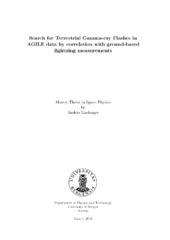Search for Terrestrial Gamma-ray Flashes in AGILE data by correlation with ground-based lightning measurements
Master thesis
Permanent lenke
https://hdl.handle.net/1956/18378Utgivelsesdato
2018-06-16Metadata
Vis full innførselSamlinger
Sammendrag
Terrestrial Gamma-ray Flashes (TGFs) are sub-millisecond bursts of high energy photons, associated with lightning flashes produced inside thunderstorms. The Astro-Rivelatore Gamma a Immagini Leggero (AGILE) satellite is one of the few satellites capable of detecting these events. Comparing gamma-ray measurements by AGILE and lightning detected by the World Wide Lightning Location Network (WWLLN), it is possible to identify TGF candidates based only on time correlation between gamma-ray and lightning data. This new algorithm is not biased by previous selection criteria, e.g. spectral hardness ratio, and can therefore find new candidates which have been overlooked before. Similar procedures have already been successfully applied to data from the Fermi and RHESSI satellites. The ultimate goal is to contribute to answering the question: how common are TGFs? Using five different datasets collected by the Mini-Calorimeter (MCAL) and the Gamma- ray Imaging Detector (GRID), between January 2008 and April 2018, a list of new TGF candidates has been obtained. The datasets are differentiated by detector attributes and variable timing accuracy. Due to a degradation of the onboard GPS timing accuracy in July 2015, the absolute timing accuracy went from μs to ms level. By assuming perfect time correlation between the WWLLN match and the TGF, these TGF candidates are used to improve the ms timing accuracy of the AGILE data after 2015 to ∼ 100 μs. A total of 439 TGF candidates are identified in the MCAL data between 23.03.15 - 14.04.18, where 396 of them are not published before.
